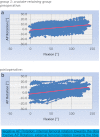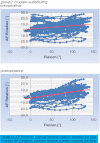Comparing navigation-based in vivo knee kinematics pre- and postoperatively between a cruciate-retaining and a cruciate-substituting implant
- PMID: 23361937
- PMCID: PMC3580100
- DOI: 10.1007/s00264-013-1798-4
Comparing navigation-based in vivo knee kinematics pre- and postoperatively between a cruciate-retaining and a cruciate-substituting implant
Abstract
Purpose: Individual physiological knee kinematics are highly variable in normal knees and are altered following cruciate-substituting (PS) and cruciate-retaining (CR) total knee arthroplasty (TKA). We wanted to know whether knee kinematics are different choosing two different knee designs, CR and PS TKA, during surgery using computer navigation.
Methods: For this purpose, 60 consecutive TKA were randomised, receiving either CR (37 patients) or PS TKA (23 patients). All patients underwent computer navigation, and kinematics were assessed prior to making any cuts or releases and after implantation. Outcome measures were relative rotation between femur and tibia, measured medial and lateral gaps and medial and lateral condylar lift-off.
Results: We were not able to demonstrate a significant difference in femoral external rotation between either group prior to implantation (7.9° CR vs. 7.4° PS) or after implantation (9.0° CR vs. 11.3° PS), both groups showed femoral roll-back. It significantly increased pre- to postoperatively in PS TKA. In the CR group both gaps increased, the change of the medial gap was significantly attributable to medial release. In the PS group both gaps increased and the change of the medial and of the lateral gap was significant. Condylar lift-off was observed in the CR group during 20° and 60° of flexion.
Conclusion: This study did not reveal significant differences in navigation-based knee kinematics between CR and PS implants. Femoral roll-back was observed in both implant designs, but significantly increased pre- to postoperatively in PS TKA. A slight midflexion instability was observed in CR TKA. Intra-operative computer navigation can measure knee kinematics during surgery before and after TKR implantation and may assist surgeons to optimise knee kinematics or identify abnormal knee kinematics that could be corrected with ligament releases to improve the functional result of a TKR, whether it is a CR or PS design. Our intra-operative finding needs to be confirmed using fluoroscopic or radiographic 3D matching after complete recovery from surgery.
Figures



References
-
- Culliton SE, Bryant DM, Overend TJ, Macdonald SJ, Chesworth BM (2011) The Relationship Between Expectations and Satisfaction in Patients Undergoing Primary Total Knee Arthroplasty. J Arthroplasty - PubMed
-
- Clarke HD, Scuderi GR. Flexion instability in primary total knee replacement. J Knee Surg. 2003;16:123–128. - PubMed
-
- Liu Y-L, Chen W-C, Yeh W-L, McClean CJ, Huang C-H, Lin K-J, Cheng C-K. Mimicking anatomical condylar configuration into knee prosthesis could improve knee kinematics after TKA - A computational simulation. Clinical Biomechanics. Bristol: Avon; 2011. - PubMed
Publication types
MeSH terms
LinkOut - more resources
Full Text Sources
Other Literature Sources
Miscellaneous

